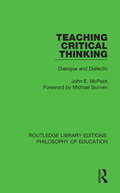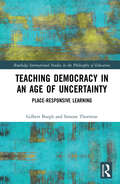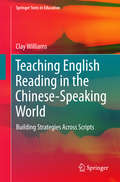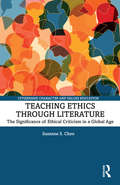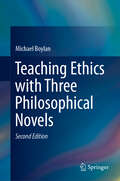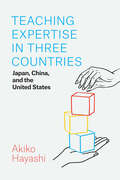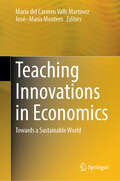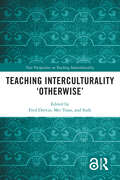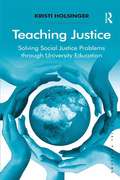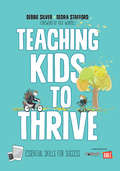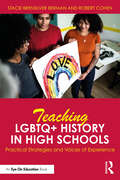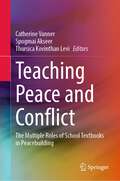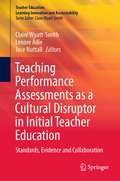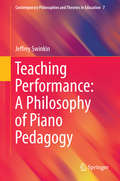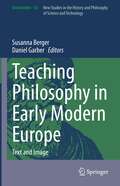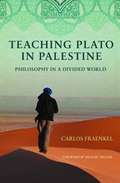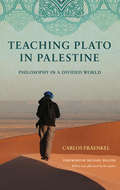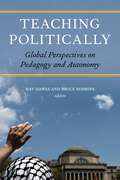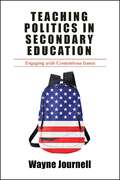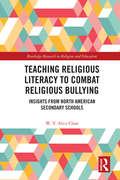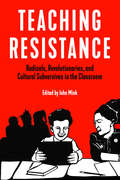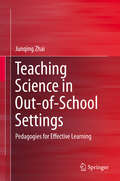- Table View
- List View
Teaching Critical Thinking: Dialogue and Dialectic (Routledge Library Editions: Philosophy of Education #13)
by John E. McPeckThis book, first published in 1990, takes a critical look at the major assumptions which support critical thinking programs and discovers many unresolved questions which threaten their viability. John McPeck argues that some of these assumptions are incoherent or run counter to common sense, while others are unsupported by the available empirical evidence. This title will be of interest to students of the philosophy of education.
Teaching Democracy in an Age of Uncertainty: Place-Responsive Learning (Routledge International Studies in the Philosophy of Education)
by Gilbert Burgh Simone ThorntonThe strength of democracy lies in its ability to self-correct, to solve problems and adapt to new challenges. However, increased volatility, resulting from multiple crises on multiple fronts – humanitarian, financial, and environmental – is testing this ability. By offering a new framework for democratic education, Teaching Democracy in an Age of Uncertainty begins a dialogue with education professionals towards the reconstruction of education and by extension our social, cultural and political institutions. This book is the first monograph on philosophy with children to focus on democratic education. The book examines the ways in which education can either perpetuate or disrupt harmful social and political practices and narratives at the classroom level. It is a rethinking of civics and citizenship education as place-responsive learning aimed at understanding and improving human-environment relations to not only face an uncertain world, but also to face the inevitable challenges of democratic disagreement beyond merely promoting pluralism, tolerance and agreement. When viewed as a way of life democracy becomes both a goal and a teaching method for developing civic literacy to enable students to articulate and apprehend more than just the predominant political narrative, but to reshape it. This book will be of interest to scholars of philosophy, political science, education, democratic theory, civics and citizenship studies, and peace education research.
Teaching English Reading in the Chinese-Speaking World
by Clay WilliamsThis book investigates inherent, structural differences in the Chinese and English writing systems which predispose learners from childhood to develop specific literacy-learning strategies, which can impair later efforts at learning foreign language literacy if the foreign language script varies significantly from the native language script. It compares educational practices and philosophies in Chinese and English-speaking classrooms, and examines the psychological underpinnings of these literacy learning strategies. This book presents psychometric testing of adult reading strategy defaults and examines case study data, revealing that Chinese students are susceptible to misapplying Chinese character-level processing strategies to English word identification tasks, which decreases reading efficiency, and ultimately can lead to learning failure. Finally, a new educational framework is proposed for teaching beginning language-specific word identification and literacy-learning skills to learners whose first language script varies significantly from that of the target language.
Teaching Ethics through Literature: Igniting the Global Imagination (Citizenship, Character and Values Education)
by Suzanne S. ChooTeaching Ethics through Literature provides in-depth understanding of a new and exciting shift in the fields of English education, Literature, Language Arts, and Literacy through exploring their connections with ethics. The book pioneers an approach to integrating ethics in the teaching of literature. This has become increasingly relevant and necessary in our globally connected age. A key feature of the book is its integration of theory and practice. It begins with a historical survey of the emergence of the ethical turn in Literature education and grounds this on the ideas of influential Ethical Philosophers and Literature scholars. Most importantly, it provides insights into how teachers can engage students in ethical concerns and apply practices of Ethical Criticism using rich on-the-ground case studies of high school Literature teachers in Australia, Singapore and the United States.
Teaching Ethics with Three Philosophical Novels
by Michael BoylanThis book offers a unique method for teaching ethics and social/political philosophy by combining primary texts and resource material along with three philosophical novels so that students can apply the abstract principles to real-life situations. A sample syllabus and sample assignments are provided. This second edition contains an additional teacher's manual, guiding instructors in how to effectively put together a course in ethics using fiction. Students often turn-off when confronted with abstract ethical principles, alone. This book allows interaction with philosophical novels that provide real-life situations that mirrors applying normative principles to lived experience. Students will be drawn into this realism and their engagement with the material will be significantly enhanced. This is an innovative textbook for teachers and students of general philosophy, ethics, business ethics, social and political philosophy, as well as students of literature and philosophy.
Teaching Expertise in Three Countries: Japan, China, and the United States
by Akiko HayashiA comparison of the development of expertise in preschool teaching in China, Japan, and the United States. In Teaching Expertise in Three Countries, Akiko Hayashi shows how teachers from Japan, China, and the United States think about what it means to be an expert teacher. Based on interviews with teachers conducted over the span of fifteen years and videos taken in their classrooms, Hayashi gives us a valuable portrait of expert teachers in the making. While Hayashi’s research uncovered cultural variations in the different national contexts, her analysis of how teachers adapted their pedagogy throughout their careers also revealed many cross-national similarities. Younger teachers often describe themselves as being in a rush, following scripts, and “talking too much,” while experienced teachers describe themselves as being quieter, knowing children better, and being more present. Including a foreword by scholar of early childhood education Joseph Tobin, Teaching Expertise in Three Countries provides a foundation for understanding the sequence and pathways of development over the first decade of teaching in three national contexts, demonstrating the value of the field of comparative education in the process.
Teaching Inclusive Education through Life Story Inquiry
by Margo Horne-Shuttleworth Monique Somma Kathy Ann WlodarczykThis practical textbook is designed as core reading for pre-service and in-service teachers and mental health practitioners in upper level Education and Psychology programs. Key concepts addressed in this case study collection include Inclusive Education as an overarching framework through the lens of Critical Disability Studies, Intersectionality and Mental Health. It portrays the first-hand accounts and lived experiences of individuals with disabilities to further understand the impact students’ classroom experiences have beyond their early school years. These accounts along with commentaries from education and health professionals inform evidence-based recommendations for educators and practitioners on prevention and intervention practices for school age children with disabilities. Readers will be prompted to consider their experiences and perspectives through chapter specific discussion-based and reflective questions that are designed to incorporate key concepts addressed throughout the text.
Teaching Innovations in Economics: Towards a Sustainable World
by José–María Montero María del Carmen Valls MartínezThis book highlights the latest technological innovations in economics education. Economics, as a discipline, not only studies the relationship between ends and scarce means, which can be used alternatively, but also serves as a social science that uses historical data to predict future events—a task complicated by the influence of human behavior. In economics, a solid theoretical foundation alone is insufficient; practical application requires a deep understanding of statistics. With the vast amount of information available today, data processing is now performed using specialized software. Consequently, teaching economics demands a wide range of complex skills that have significantly evolved in recent years, driven by the growing interest in educational innovation among professors and scientists, further accelerated by advancements in new technologies. Moreover, economics education is increasingly aligned with the global concern for sustainability, as emphasized in the United Nations' Agenda 2030. Professors are now integrating sustainability into syllabi and teaching methodologies. This book covers key topics such as: Technological and innovative advancements in economics education. New teaching-learning theories and models in economics education. The impact of digital transformation on economics education. The role of artificial intelligence in economics education. Addressing special educational needs in economics education. Evaluation of the teaching-learning process in economics. Assessment of student learning in economics. Development of materials and tools for economics education. Final projects (Undergraduate and Master's) in economics. Authored by leading professors and researchers in the field, this book presents a collection of chapters that rigorously explore teaching innovations in economics.
Teaching Interculturality 'Otherwise' (New Perspectives on Teaching Interculturality)
by Fred Dervin, Mei Yuan, and SudeThis edited volume focuses on the thorny and somewhat controversial issue of teaching (and learning) interculturality in a way that considers the notion from critical and reflexive perspectives when introduced to students. Comprised of three parts, the book discusses the nuts and bolts of teaching interculturally, considers changes in the teaching of interculturality, and provides pedagogical insights into interculturalising the notion. It studies both teaching im-/explicitly about interculturality and how to incorporate interculturality into teaching practices or into an institution. By sharing varied cases and theoretical reflections on the topic, the editors and contributors from different parts of the world aim to stimulate more initiatives to enrich the field instead of delimiting it, especially in complement to and beyond the 'West' or 'Global North', and also to build up further reflexivity in the way readers engage with interculturality in education. This will be a must-read for teachers and researchers of intercultural communication education at different educational levels, as well as anyone interested in scholarship on education for interculturality.
Teaching Justice: Solving Social Justice Problems through University Education (Solving Social Problems)
by Kristi HolsingerTeaching Justice explores the role that teaching and learning in higher education can play in solving problems of social injustice. Examining a range of approaches to education, it considers the challenges that exist in teaching about justice, drawing on extensive empirical data gathered amongst college lecturers and professors, as well as the author's own experience. With an analysis of the strategies commonly used this book will shed light on the manner in which students can be engaged in activism and concerned with issues of social injustice. By overcoming apathy and engaging students with social problems, education can thus address matters of injustice and begin to effect change. Presenting extensive international research and insightful analyses, Teaching Justice reveals the classroom and the lecture theatre to be important sites in the pursuit of social justice and will appeal to teachers and researchers with interests in social problems, education and educational methods, and criminal justice, as well as community engagement and service learning outside the classroom.
Teaching Kids to Thrive: Essential Skills for Success
by Debbie Thompson Silver Ms Dedra A. StaffordThere’s more to student success than standards and test scores… Integrating Social and Emotional Learning into a curriculum has been shown to increase personal and school-wide growth. With lifelong success the goal over simply meeting academic thresholds, Teaching Kids to Thrive presents strategies, activities, and stories in an approachable way to develop responsible, self-motivated learners. Uniting social, academic, and self-skills this instrumental resource offers benefits to students such as: Using mindfulness strategies to help students tap their inner strengths Learning to self-regulate and control other executive brain functions Developing growth mindsets along with perseverance and resilience Cultivating a sense of responsibility, honesty, and integrity Encouraging a capacity for empathy and gratitude
Teaching Kids to Thrive: Essential Skills for Success
by Debbie Thompson Silver Ms Dedra A. StaffordThere’s more to student success than standards and test scores… Integrating Social and Emotional Learning into a curriculum has been shown to increase personal and school-wide growth. With lifelong success the goal over simply meeting academic thresholds, Teaching Kids to Thrive presents strategies, activities, and stories in an approachable way to develop responsible, self-motivated learners. Uniting social, academic, and self-skills this instrumental resource offers benefits to students such as: Using mindfulness strategies to help students tap their inner strengths Learning to self-regulate and control other executive brain functions Developing growth mindsets along with perseverance and resilience Cultivating a sense of responsibility, honesty, and integrity Encouraging a capacity for empathy and gratitude
Teaching LGBTQ+ History in High Schools: Practical Strategies and Voices of Experience
by Robert Cohen Stacie Brensilver BermanTeaching LGBTQ+ History in High Schools: Practical Strategies and Voices of Experience offers insights, concrete strategies, and lesson plans for teaching LGBTQ+ history in high schools. With essays from educators, historians, and activists, it speaks to the power and significance of LGBTQ+-inclusive curriculum and its greater necessity at a time when the LGBTQ+ community is both more visible and increasingly targeted.Across the US, challenges exist that prevent teaching LGBTQ+ history, including curriculum censorship laws prohibiting discussion of the LGBTQ+ community in schools. However, there are also grassroots movements in the US that are generating quality LGBTQ+ history curriculum and implementing them in secondary schools. This book shows how integrating LGBTQ+ content offers myriad benefits for all students, including making history more relevant and representative, and reversing years of silence and erasure in the sources, topics, and narratives that students encounter throughout their education.Combining insights from changemakers with practical strategies and lesson plans for teaching LGBTQ+ history, this book will equip educators with the rationale and resources they need to effectively integrate this history into the curriculum. It will also be highly valuable for pre-service teachers, particularly within Social Studies Education and Social Justice Education.
Teaching Peace and Conflict: The Multiple Roles of School Textbooks in Peacebuilding
by Catherine Vanner Spogmai Akseer Thursica Kovinthan LeviThis book illustrates the multiple roles of textbooks as victim, transformer, and accomplice to conflict by introducing the Intersecting Roles of Education in Conflict (IREC) framework for use in the research, development, production, distribution, and dissemination of textbooks and learning materials. The framework illustrates these three potentially overlapping roles by mapping the complex educational contexts of conflict-affected societies and considering how textbooks, learning materials, and education systems more broadly may simultaneously operate within these various roles. Country case studies from Asia, Europe, Africa, and the Middle East are used to analyze primary and secondary school textbook development, content, and application from a variety of approaches that articulate conflict as protracted and/or socio-political violence. The breadth of case studies shows how conflict discourse circulates in educational systems and materials in a wide range of contexts, indicating that the complexity of the relationship between textbooks and conflict is not unique to one culture, geographic region, or type of conflict.
Teaching Performance Assessments as a Cultural Disruptor in Initial Teacher Education: Standards, Evidence and Collaboration (Teacher Education, Learning Innovation and Accountability)
by Claire Wyatt-Smith Joce Nuttall Lenore AdieThis book explores how well teachers are prepared for professional practice. It is an outcome of a large-scale research and development program that has collected extensive data on the impact of the Graduate Teacher Performance Assessment on Initial Teacher Education programs and preservice teachers’ engagement with the assessment. It contributes to international debates in teacher education by examining an Australian experience of teacher performance assessments as a catalyst for cultural change and practice reform in teacher education. The respective chapters describe and critique this unique, multi-institutional investigation into the quality of teacher education and present substantial evidence, drawing on a variety of conceptual, empirical and methodological entry points. Further, they address the intellectual, experiential and personal resources and related expertise that teacher educators and preservice teachers bring to their practice. Taken together, they offer readers clearly conceptualised and evidence-rich accounts of site-specific and cross-site investigations into cultural, pedagogical and assessment change in Initial Teacher Education.
Teaching Performance: A Philosophy of Piano Pedagogy
by Jeffrey SwinkinHow can the studio teacher teach a lesson so as to instill refined artistic sensibilities, ones often thought to elude language? How can the applied lesson be a form of aesthetic education? How can teaching performance be an artistic endeavor in its own right? These are some of the questions Teaching Performance attempts to answer, drawing on the author's several decades of experience as a studio teacher and music scholar. The architects of absolute music (Hanslick, Schopenhauer, and others) held that it is precisely because instrumental music lacks language and thus any overt connection to the non-musical world that it is able to expose essential elements of that world. More particularly, for these philosophers, it is the density of musical structure--the intricate interplay among purely musical elements--that allows music to capture the essences behind appearances. By analogy, the author contends that the more structurally intricate and aesthetically nuanced a pedagogical system is, the greater its ability to illuminate music and facilitate musical skills. The author terms this phenomenon relational autonomy. Eight chapters unfold a piano-pedagogical system pivoting on the principle of relational autonomy. In grounding piano pedagogy in the aesthetics of absolute music, each domain works on the other. On the one hand, Romantic aesthetics affords pedagogy a source of artistic value in its own right. On the other hand, pedagogy concretizes Romantic aesthetics, deflating its transcendental pretentions and showing the dichotomy of absolute/utilitarian to be specious.
Teaching Philosophy in Early Modern Europe: Text and Image (Archimedes #61)
by Daniel Garber Susanna BergerThis book examines how philosophy was taught in the early modern period in Europe. It breaks new ground in a number of ways. Firstly, it seeks to bring text-based scholars in the history of philosophy together with social and cultural historians to examine the interaction between tradition and innovation in the early modern classroom, the site where traditional views of the world were transmitted to the generation that was to give birth to modern philosophy and science. Secondly, it draws together scholars who are centered on ideas and words with other scholars who focus on the role of images in the classroom and the intellectual world in this central period of history. The volume advances our understanding of how philosophy was understood and transmitted in this rich and crucial era. The principal audience for Teaching Philosophy are historians of science, philosophy, art, visual culture, and print culture. The chapters are written in a tone accessible to upper-level undergraduates and graduate students. It also reaches non-specialist readers interested in subjects including the “scientific revolution,” the organization of information, and Renaissance and Baroque visual art.
Teaching Philosophy: A Guide
by Steven M. CahnSome students find philosophy engrossing; others are merely bewildered. How can professors meet the challenge of teaching introductory-level philosophy so that their students, regardless of initial incentive or skill, come to understand and even enjoy the subject? For nearly a decade, renowned philosopher and teacher Steven M. Cahn offered doctoral students a fourteen-week, credit-bearing course to prepare them to teach undergraduates. At schools where these instructors were appointed, department chairs reported a dramatic increase in student interest. In this book, Cahn captures the essence of that course. Yet many of the topics he discusses concern all faculty, regardless of subject: a teacher’s responsibilities, the keys to effective instruction, the proper approach to term papers, examinations, and grades; and suggestions for how administrators should demonstrate that they take teaching seriously. Such matters are covered in the first seven chapters and in the final, fourteenth chapter. The intermediate six chapters focus on teaching introductory philosophy and, in particular, on critical thinking, free will, philosophy of religion, ethics, and political philosophy. Cahn’s writing is lucid and lively, using vivid examples and avoiding educational jargon. In sum, this book is not only a guide on how to inspire students but also an inspiration for teachers themselves.
Teaching Plato in Palestine
by Michael Walzer Carlos FraenkelTeaching Plato in Palestine is part intellectual travelogue, part plea for integrating philosophy into our personal and public life. Philosophical toolkit in tow, Carlos Fraenkel invites readers on a tour around the world as he meets students at Palestinian and Indonesian universities, lapsed Hasidic Jews in New York, teenagers from poor neighborhoods in Brazil, and the descendants of Iroquois warriors in Canada. They turn to Plato and Aristotle, al-Ghazālī and Maimonides, Spinoza and Nietzsche for help to tackle big questions: Does God exist? Is piety worth it? Can violence be justified? What is social justice and how can we get there? Who should rule? And how shall we deal with the legacy of colonialism? Fraenkel shows how useful the tools of philosophy can be--particularly in places fraught with conflict--to clarify such questions and explore answers to them. In the course of the discussions, different viewpoints often clash. That's a good thing, Fraenkel argues, as long as we turn our disagreements on moral, religious, and philosophical issues into what he calls a "culture of debate." Conceived as a joint search for the truth, a culture of debate gives us a chance to examine the beliefs and values we were brought up with and often take for granted. It won't lead to easy answers, Fraenkel admits, but debate, if philosophically nuanced, is more attractive than either forcing our views on others or becoming mired in multicultural complacency--and behaving as if differences didn't matter at all.
Teaching Plato in Palestine: Philosophy in a Divided World
by Michael Walzer Carlos FraenkelTeaching Plato in Palestine is part intellectual travelogue, part plea for integrating philosophy into our personal and public life. Philosophical toolkit in tow, Carlos Fraenkel invites readers on a tour around the world as he meets students at Palestinian and Indonesian universities, lapsed Hasidic Jews in New York, teenagers from poor neighborhoods in Brazil, and the descendants of Iroquois warriors in Canada. They turn to Plato and Aristotle, al-Ghaz?l? and Maimonides, Spinoza and Nietzsche for help to tackle big questions: Does God exist? Is piety worth it? Can violence be justified? What is social justice and how can we get there? Who should rule? And how shall we deal with the legacy of colonialism? Fraenkel shows how useful the tools of philosophy can be--particularly in places fraught with conflict--to clarify such questions and explore answers to them. In the course of the discussions, different viewpoints often clash. That's a good thing, Fraenkel argues, as long as we turn our disagreements on moral, religious, and philosophical issues into what he calls a "culture of debate." Conceived as a joint search for the truth, a culture of debate gives us a chance to examine the beliefs and values we were brought up with and often take for granted. It won't lead to easy answers, Fraenkel admits, but debate, if philosophically nuanced, is more attractive than either forcing our views on others or becoming mired in multicultural complacency--and behaving as if differences didn't matter at all.
Teaching Politically: Global Perspectives on Pedagogy and Autonomy
by May Hawas and Bruce RobbinsCulture is inextricable from politics. This includes the politics of who we are, as teachers, intellectuals, writers, cultural workers, and students, and what we want to bring to and take from the site of instruction. It also includes the politics of who we want to be, as citizens, professionals, and active contributors to our communities and to the world in general, and what we can be, realistically, in the particular contexts in which we live. Teaching Politically addresses some of the political constraints that shape our pedagogical spaces, especially in the teaching of literature. The book brings together a global group of academics, activists, public intellectuals, poets, and novelists to examine the way politics manifest pedagogically, and how a commitment to educating manifests politically, in and beyond the classroom. At the heart of the discussion is how political and professional paradigms chafe against, intersect with, or otherwise become inseparable from each other in any vocation that attempts to educate: from writing, journalism, and public speaking to art, activism, and medicine.Contributors: Dimitris Christopoulos, Dimitri Dimoulis, Khaled Fahmy, Rishi Goyal, May Hawas, Bonnie Honig, Mona Kareem, Benjamin Mangrum, Nora Parr, Bruce Robbins, Ahdaf Soueif, Omid Tofighian, Elahe Zivardar
Teaching Politics in Secondary Education: Engaging with Contentious Issues
by Wayne JournellWinner of the 2018 Exemplary Research in Social Studies Award presented by the National Council for the Social StudiesMany social studies teachers report feeling apprehensive about discussing potentially volatile topics in the classroom, because they fear that administrators and parents might accuse them of attempting to indoctrinate their students. Wayne Journell tackles the controversial nature of teaching politics, addressing commonly raised concerns such as how to frame divisive political issues, whether teachers should disclose their personal political beliefs to students, and how to handle political topics that become intertwined with socially sensitive topics such as race, gender, and religion. Journell discusses how classrooms can become spaces for tolerant political discourse in an increasingly politically polarized American society. In order to explore this, Journell analyzes data that include studies of high school civics/government teachers during the 2008 and 2012 presidential elections and how they integrated television programs, technology, and social media into their teaching. The book also includes a three-year study of preservice middle and secondary social studies teachers' political knowledge and a content analysis of CNN Student News.
Teaching Religious Literacy to Combat Religious Bullying: Insights from North American Secondary Schools (Routledge Research in Religion and Education)
by W. Y. ChanThis text explores the phenomenon of religious bullying as it manifests in two North American contexts and theorizes religious literacy as a viable school-based intervention to promote understanding of religious and non-religious difference. Using substantive, qualitative data from schools and communities in California and Quebec, Teaching Religious Literacy to Combat Religious Bullying examines the impact of mandatory religious literacy courses delivered in secondary schools and identifies curricula, teacher attitudes, training, and administrative support as key determinants of course impact. Drawing on Bronfenbrenner’s social-ecological framework, the text then illustrates how the environmental factors both in and outside of the school considerably influence teacher and student attitudes to religious and non-religious traditions. Practical recommendations are made to combat overarching societal trends and religious discrimination within the classroom, and context is cited as key to an effective discussion on religious literacy more broadly. This text will benefit researchers, academics, and educators with an interest in religious literacy, religious education, the sociology of education, and those looking at the field of bullying and truancy more widely. Those interested in intersectionality, marginalized communities, secularism, and educational policy will also benefit from the volume.
Teaching Resistance: Radicals, Revolutionaries, and Cultural Subversives in the Classroom
by John MinkTeaching Resistance is a collection of the voices of activist educators from around the world who engage inside and outside the classroom from pre-kindergarten to university and emphasize teaching radical practice from the field. Written in accessible language, this book is for anyone who wants to explore new ways to subvert educational systems and institutions, transform educational spaces, and empower students and teachers to fight for genuine change. Topics include community self-defense, Black Lives Matter and critical race theory, intersections between punk/DIY subculture and teaching, ESL, anarchist education, Palestinian resistance, trauma, working-class education, prison teaching, the resurgence of (and resistance to) the Far Right, special education, antifascist pedagogies, and more. Edited by social studies teacher, author, and punk musician John Mink, the book features expanded entries from the monthly column in the politically insurgent punk magazine Maximum Rocknroll, plus new works and interviews with subversive educators. Contributing teachers include Michelle Cruz Gonzales, Dwayne Dixon, Martín Sorrondeguy, Alice Bag, Miriam Klein Stahl, Ron Scapp, Kadijah Means, Mimi Nguyen, Murad Tamini, Yvette Felarca, Jessica Mills, and others.
Teaching Science in Out-of-School Settings
by Junqing ZhaiThis book explores pedagogical approaches used by informal science educators and botanic garden educators in particular, when teaching science to visiting students (7-12 years old). More specifically, it draws on the sociocultural perspective of learning, and highlights the importance of discourse in learning processes. It examines the interactions between four botanic garden educators (BGEs) and their students, focusing on how the students' contributions to the talk are followed up on by the BGEs. Moreover, it includes an investigation into which kinds of teaching behaviours on the part of BGEs can best support learning.
